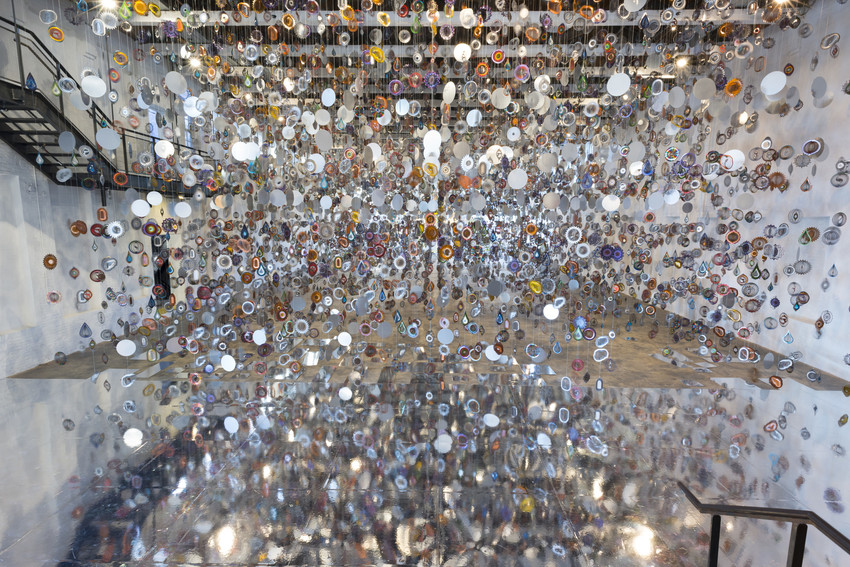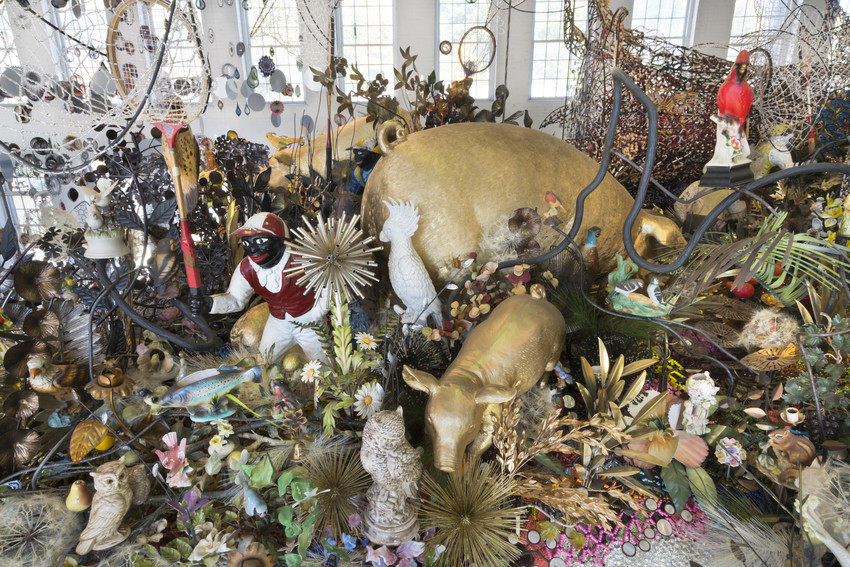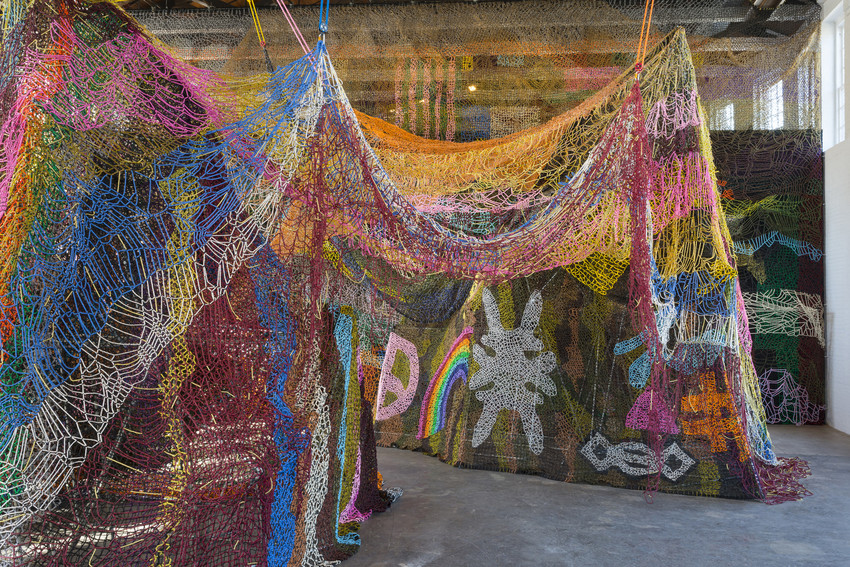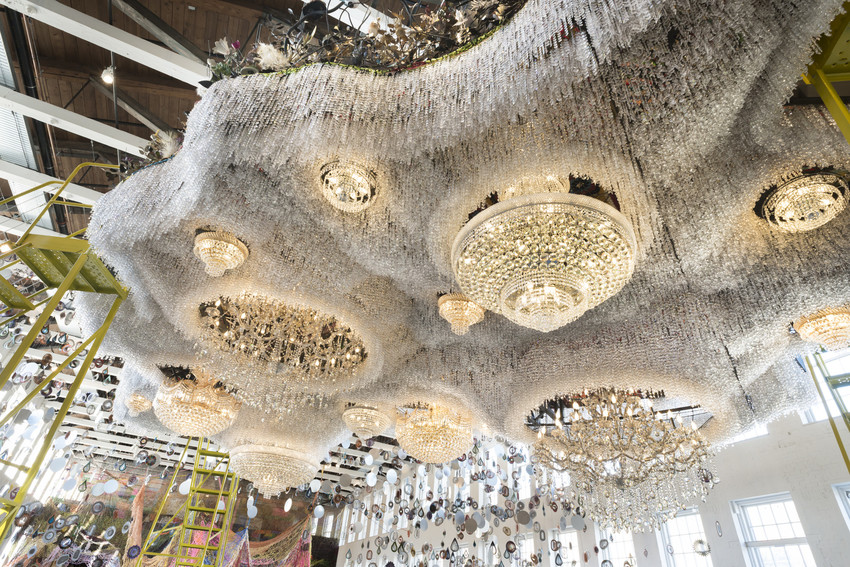Nick Cave created his first Soundsuit after the Rodney King beating in 1992. Cave was sitting in a park, feeling vulnerable and cast aside, when he saw a discarded twig on the ground. Later he fabricated a symbolic suit of armor, using hundreds of collected twigs. The Soundsuits became integral parts of Cave’s practice, and this original experience also awakened a sense of civic responsibility in the artist.
The buoyant appearance of the Soundsuits, composed of kitschy materials such as beads and plastic tchotchkes, belies their serious connotations. Cave points to gun violence and racism in this country as the driving forces for his wearable sculptures. The Soundsuits mask the identity of the wearer, allowing viewers to contemplate the absence of systemic social abuses of race, gender, and class.
On October 16, 2016, Cave’s largest and most personal installation opened at the Massachusetts Museum of Contemporary Art in North Adams (MASS MoCA). Three years ago, the museum’s curator Denise Markonish invited Cave to show in the notorious Building 5 at MASS MoCA, a cavernous space as long as a football field, but her invitation came with a caveat: no Soundsuits.
Cave and I talked on the phone about his exhibition, Until, and how his work will stimulate questions about equality in America.
Jacquelyn Gleisner: Until is your largest installation to date, featuring more than a dozen Black lawn jockeys, twenty thousand wind spinners, and more than ten miles of crystals. Notably, your installation does not contain a single Soundsuit. Could you explain how the imagery in this installation has evolved from the Soundsuits?
Nick Cave: When the project was offered, the curator wanted me to establish new work that was not Soundsuits; I was already in the process of moving away from them. And, in fact, my most recent two exhibitions at Jack Shainman Gallery did not contain any Soundsuits.
For the MASS MoCA show, I wanted to put the viewer into the metaphorical belly of a Soundsuit. I wanted to talk about what really provokes me to do the work that I do, what gets me charged, and what is disturbing to me. I wanted to say something about issues that are important to me.
As I was developing this project, the Michael Brown incident happened in Ferguson, Missouri; Freddie Gray went down, and then Eric Garner, Sandra Bland, and Christian Taylor. I was in the studio, thinking, “What the hell is going on?” All of these events made me wonder whether there is racism in heaven, and that really was the beginning of the show.
JG: How does the question, “Is there racism in heaven?” connect to the show’s title, Until?
NC: The title comes from the phrases “innocent until proven guilty” or “guilty until proven innocent.” Both are linked to police brutality in America. This morning, the Chicago crime stats came out for the month of October. Seventy-two people were shot and killed in October. Five hundred eighty-two people have been killed so far this year. I feel called to action, and I’m trying to find a way, as a visual artist with a specific sense of responsibility, to be proactive. How can I create a project that will reach hundreds of thousands of people and raise their level of consciousness about these issues?
JG: The first Soundsuit was a response to the beating of Rodney King, and more recently you created a Soundsuit after Trayvon Martin’s death, called TM13. As you mentioned, other instances of police brutality and violence were important catalysts for your show at MASS MoCA. You have talked about how the first Soundsuit changed you as an artist and how you began to embrace the idea of civic responsibility. What is your responsibility to an audience, as a contemporary artist?
NC: The incident in 1992 put me in a very vulnerable position; [it made me defensive]. I feel like I’m protected only in the privacy of my own space; the moment that I walk out of my home, I can be profiled, and I am looked at very differently. I saw myself differently after [the King beating]. Suddenly, I could be guilty until proven innocent.
That incident was so profound in terms of how it made me feel. I felt that I needed to do something, as a Black male living in this country. That’s when I knew that there was a shift in my purpose. [The beating was a sign] for me to take responsibility. From that moment, I became an artist with a conscience. I am an artist with a civic responsibility. I [am invigorated] by dealing with these really hard issues around race and gun violence. There’s an urgency I feel, as an artist, as an African American man, as a citizen of the United States, and as a resident of Chicago. The Rodney King beating put me in the position to be the voice of the innocent. Lives matter, not just Black lives. All lives matter.
JG: You’ve said that you look for a sense of humility in the objects and materials you use in your sculptures. Can you explain the process of amassing and editing the elaborate collection of objects in the installation at MASS MoCA?
NC: I was collecting objects that speak about nostalgic moments in history. For example, I found seventeen Black lawn jockeys. I am interested in the repressed, dark, and racial commentary embodied in these artifacts. I knew that these were loaded objects, and I was very interested in not only the power within these objects but also how I could make decisions to reposition them. The lawn jockeys often hold lanterns in a subservient position; in this installation, I wanted to shift that [image]. The lawn jockeys at MASS MoCA are all holding beaded dream catchers—my effort to speak about optimism. I’m taking a stance. Yes, these objects are out there, in the space of disparity and repression, but I do not operate there. I’m responding to it by designing my own pathway and creating my own lifestyle. In spite of everything that’s happening, I can take control over my destiny and respond to these horrific concerns.
JG: With that optimism in mind, you’ve described yourself as a messenger who brings people together to heal through art. You’ve stated that you’d like your art to function as a form of diplomacy. Could you talk about how your art is a part of the healing process for issues like gun violence and racial injustice in this country?
NC: I think I’m a messenger first and an artist second. My projects are like deeds that I need to deliver, and then I move on. Although they pass through me, I don’t feel connected to them, in a certain sense. Rather, I feel like I’m the one who has been chosen to deliver them. I’ve been called to do this work.
This exhibition is also a space for convening. It becomes a safe haven for hard conversations. I want the space to be one where young people and adults can gather to talk about difficult situations.
JG: As viewers interact with this space, what kind of imagery will inspire challenging conversations?
NC: The installation opens with this kinetic force composed of sixteen thousand wind spinners. The floor is reflective, intensifying the presence of the wind spinners. There are traditional wind-spinner shapes, like butterflies and birds but, as you walk through, you notice that a number of these spinners are custom-made: there are guns, bullets, targets, and teardrops.
As you move through the installation, you enter a crystal cloudscape, an enormous sculptural object suspended in the air. You also have the option to climb eighteen feet up, on industrial ladders, into this topographical landscape, which is like a forbidden garden holding these exotic wind catchers. There is darkness all the way through, but there are also moments of extreme glory.
Eventually you come to this landscape of mountains made of beaded camouflage nets. You pass through this [immersive] environment to find the video installation. Then you walk upstairs to the mezzanine level to see a waterfall made of Mylar streamers. At that point, you’ve gone through the entire installation, and there’s a moment of [feeling cleansed and quieted].
The interesting thing about this show is that, in order to leave the space, you have to walk through the installation again. You cannot walk through the space without sharing what you’re experiencing. You find that you’re not alone, going through this experience. The exhibition is really intended to be a shared experience.
JG: Now that you’ve completed this project, what’s next?
NC: At the moment, we are planning the programming for the MASS MoCA project, with a series of performances in the space over the next year. For example, Solange Knowles will perform there. We have about ten performers that will present or perform in the space through the duration of the show. I’m also excited to stand back and watch how Until will deliver itself to viewers.
Nick Cave’s Until will be on view at MASS MoCA through September 3, 2017.








